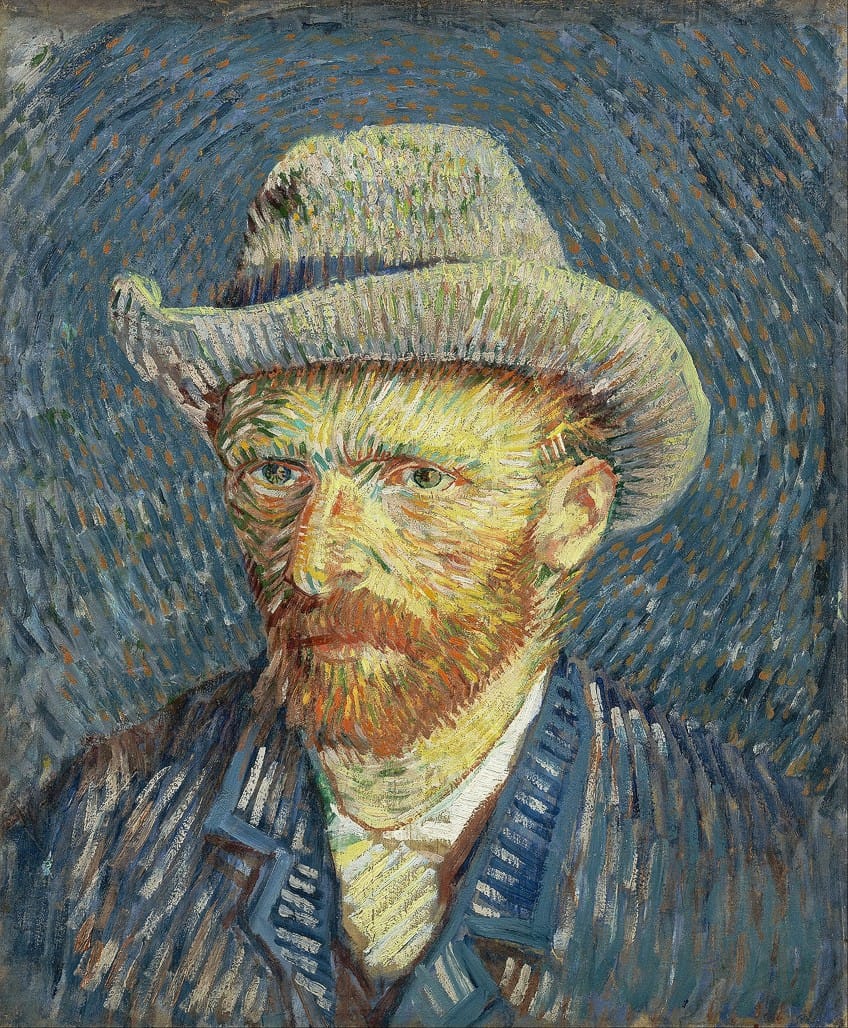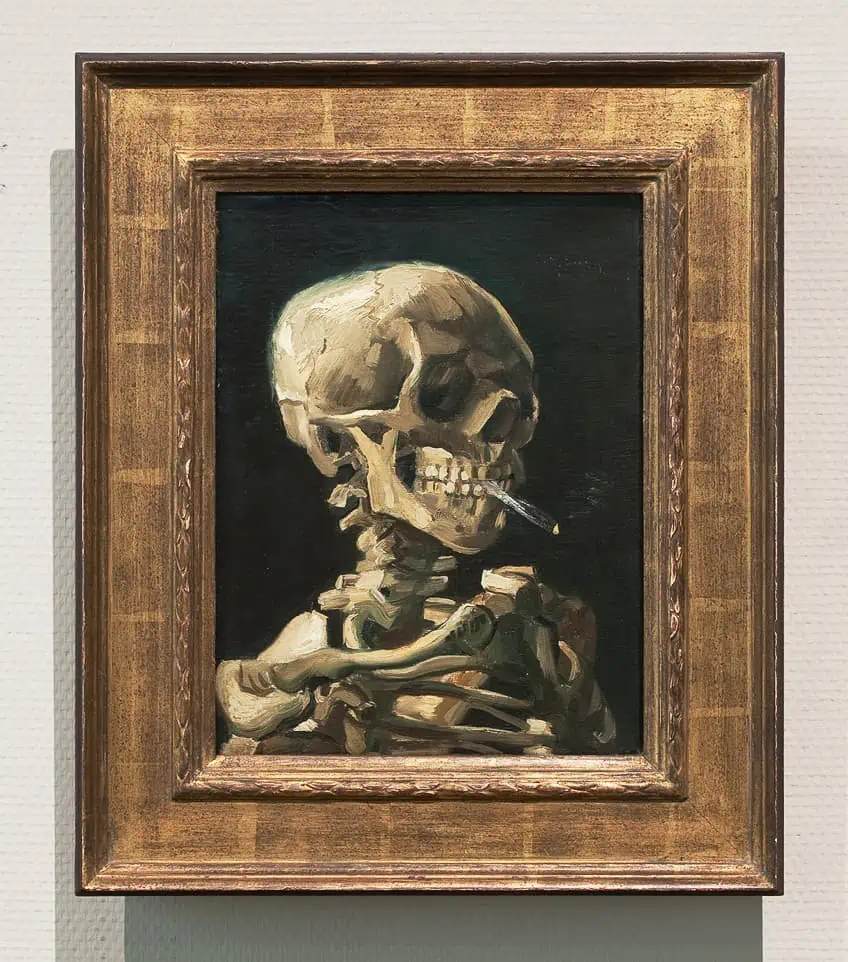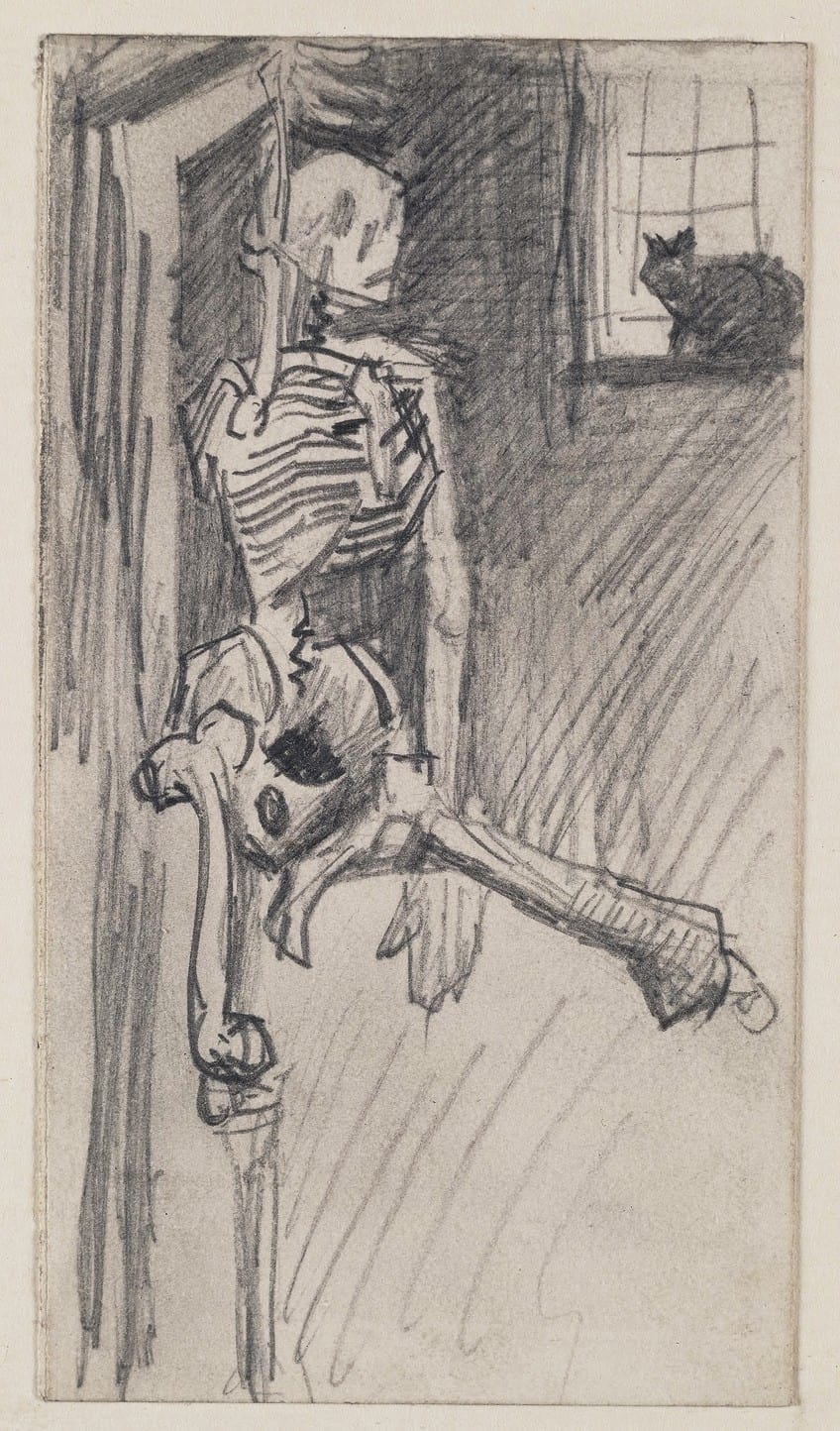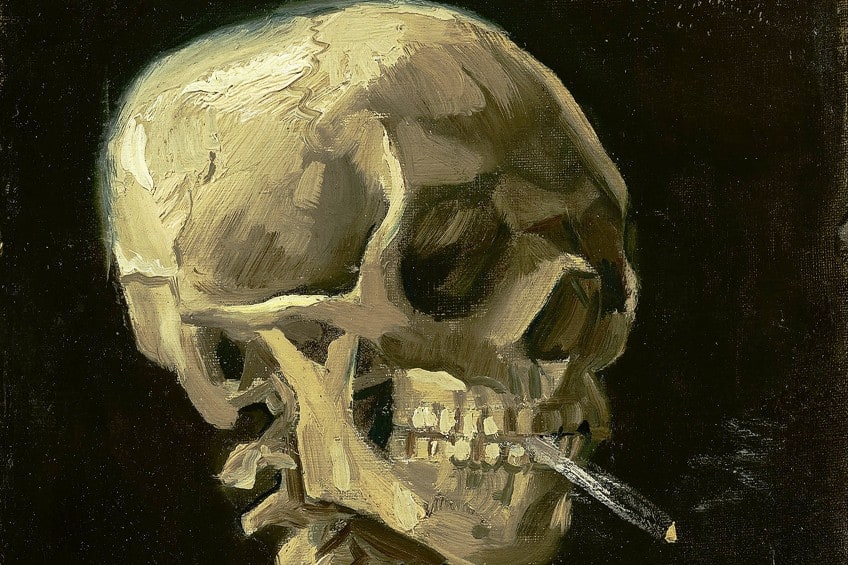“Skeleton Smoking” by Vincent van Gogh – The Smoking Skull
Everyone has surely seen Vincent van Gogh’s famous paintings of flowers and the night sky, but have you ever seen Van Gogh’s skeleton painting? That’s right, there is a painting of a smoking skull by Van Gogh, and it is a rather striking piece of art! Van Gogh’s skull painting is both undated and quite small, yet it is still regarded as a significant artwork created during his time in Antwerp. Let’s learn more about the painting of a skeleton smoking by Vincent van Gogh in the article below.
Contents
Skull of a Skeleton with Burning Cigarette (c. 1886) by Vincent van Gogh
| Artist | Vincent van Gogh (1853 – 1890) |
| Date of Completion | c. 1886 |
| Medium | Oil on canvas |
| Dimensions (cm) | 32 x 24 |
| Location | Van Gogh Museum, Amsterdam, Netherlands |
The painting of a skeleton smoking by Vincent van Gogh is currently part of the Van Gogh Museum’s permanent collection. Van Gogh’s skull painting was probably created as a humorous satire on conservative academic practices during the winter of 1885 to 1886. Before the use of real humans as models became prevalent, the academic art practice involved the study of skeletons in order to develop a grasp of human anatomy.
At the time, Van Gogh was in Antwerp, Belgium, attending lessons at the Royal Academy of Fine Arts, which he subsequently described as uninteresting and that he learned nothing while in attendance there.

Because he was in ill health at the time of making the painting, many consider it to be a memento mori painting, which is created to remind one of one’s own imminent death. Despite being perceived by some as a condemnation of smoking, Vincent van Gogh was actually an avid smoker who smoked until his death in 1890.
The Background of the Painting of a Skeleton Smoking by Vincent van Gogh
Vincent van Gogh’s colorful, hallucinogenic visions come to mind when you think of his art. You think of the starry skies, bright yellow, and piercing self-portraits that he has become known for over time. With its toothy smile and hanging cigarette, Van Gogh’s skull is quite another beast altogether. It lacks Van Gogh’s distinctive whirling brushstrokes and vivid color since it is executed in monochrome on a stark black backdrop. His strokes are free, even casual, capturing shape and shadow with only a few strokes. It’s straightforward and even rather amusing.
However, we do not know if he found it amusing, as Van Gogh’s mental condition during the production of this artwork is not well recorded.
Theodorus, Van Gogh’s father, passed away earlier in the year, and the artist had left Nuenen after making a rival of the local priest by getting one of his sitters pregnant. Van Gogh then subsequently moved to Antwerp and resided in a small flat above a paint dealer’s store, using the meager stipends supplied to him by his brother on art materials and subsisting on bread, coffee, and tobacco. It is worth mentioning, however, that Van Gogh tried his hand at various techniques and subjects throughout his stay in Antwerp. He experimented with several genres, including portraiture, still life, and anatomical studies.

His interest in researching human anatomy, as well as his desire to better his grasp of the human form, was most likely what motivated Van Gogh’s skull painting. The painting of the smoking skull by van Gogh is in many respects, the most important painting made in Antwerp. Van Gogh was ridiculing the traditional techniques in drawing schools, where a skeleton regularly served as the foundation of anatomical studies. The skeleton’s lifelessness was regarded as the polar opposite of what van Gogh usually intended a painting to convey.
Van Gogh’s skull painting gained a grotesquely humorous touch of life with the burning cigarette wedged in its jaws, despite the fact that it is still comprised of nothing but lifeless bones.
When we consider van Gogh’s desire to improve his exterior appearance, the image becomes less amusing. He had just had extensive dental work. He produced no self-portraits in Nuenen, but in Paris, he dealt with the challenge head-on – and the explanation for this could well have been because van Gogh had lately gained a touch of vanity, and he didn’t consider himself socially acceptable until the gap in his teeth had been corrected.

Van Gogh’s skull might be seen as van Gogh’s first self-portrait – a caustic, harsh remark on an unkempt and unappealing look that had been an expression of unity with the villagers in Nuenen but became a source of shame and an issue in the metropolis. The Van Gogh skeleton painting could possibly have been inspired by the works of the Dutch artist from the 17th century, Hercules Segers, or Félicien Rops, van Gogh’s Belgian contemporary. Vincent van Gogh is believed to have acquired a copy of Rops’ Uilenspiegel, a satirical arts periodical, and the painting by Rops called The Husbands’ Train: The Death of the Sinner, reveals a definite influence on Van Gogh’s own paintings.
While it is unknown if Van Gogh was definitely aware of Segers’ paintings, he did have a broad knowledge of Dutch artists from the 17th to the 19th centuries.
Vincent van Gogh’s brother Theo van Gogh had the picture in his possession at the time of his passing in 1891. Van Gogh’s skeleton painting was then inherited by Johanna van Gogh-Bonger, his wife, until her eventual passing in 1925, and subsequently by Vincent Willem van Gogh, their son, until 1962, when the Van Gogh Foundation eventually purchased it. From 1962 until 1973, it was on loan to the Stedelijk Museum in Amsterdam, and since 1973, it has been on permanent exhibition at the Van Gogh Museum.
Van Gogh’s Love for Smoking
Vincent van Gogh once wrote from his home in Arles that he believed “the finest artworks are that one envisions while smoking in one’s bed. In one of his letters to his friend Emile Bernard, he emphasized that it was difficult to make paintings as lovely as the excellence of nature’s glorious splendors yet that one should still strive to do so. A few months after that, he wrote to Emile Bernard once again, suggesting that in order to accomplish an excellent job, one must eat well, live well, drink coffee, and smoke in peace.
Despite the fact that most parts of Van Gogh’s life have been exhaustively researched since his death, the importance of his smoking habit has gotten comparatively little study. But smoking was important to Van Gogh as he used it as a form of comfort while dealing with the never-ending obstacles he faced.
When he was 19, he even wrote to his brother, encouraging him to start smoking as it helped put him in good spirits. He even once described his own pipe as a trusty old friend! An elderly tailor from the Van Gogh family’s town of Helvoirt once remembered washing Vincent’s clothing during a visit at Christmas time. Frederick van de Plas said that the suit smelled foul from smoke and was utterly unpresentable”. When he was 23, he was working as a teacher in West London, and his landlady complained about the odor of his smoke. As a result, he handed her perfumed flowers.

Van Gogh had become hooked on smoking by this point. Despite failing to sell his art, he apparently even gave a painting to Jansje van den Broek, the local tobacconist in payment of an outstanding bill for tobacco in 1884. After his father, Theodorus, passed away following a stroke in 1885, Van Gogh created a memorial still life that contained his father’s pipe and tobacco bag. He later reused the canvas to save money, but a watercolor is still extant. Tobacco was always a burden on Van Gogh’s already-drained finances.
When Paul Gauguin eventually joined him in the Yellow House, he was taken aback by how much money was being squandered. Gauguin consequently split their funds between brothel trips and tobacco purchases.
Van Gogh thought that his pipe had a soothing effect right up until the end of his life, but it couldn’t save the artist from his impending demise. On the 27th of July, 1890, he stumbled back to his bedroom at the little inn after being wounded by a pistol shot. Van Gogh requested his pipe, which was still in his waistcoat pocket when Dr. Paul Gachet arrived. Vincent van Gogh was said to have sat there, smoking quietly. He died the very next day.
Interpretations of Van Gogh’s Skeleton Painting
Interpretations of the smoking skull by Van Gogh differ, as they always do. Some regard it as an expression of death and mortality, a vanitas prompted by the loss of his father or Van Gogh’s own ill health at the time. Because of its representation of a skull, which is a prominent symbol of mortality in these types of artworks, it has often also been identified with the memento mori genre. The presence of a burning cigarette illustrates the idea of mortality by implying the impermanence and temporariness of existence.
The burning cigarette, as with life, burns and ultimately goes out. Van Gogh’s skeleton painting’s dark background and solemn tone also add to the connection with vanitas or memento mori art. The lack of vivid hues, as well as the focus placed on the skull symbolism, are consistent with the visual and thematic features of this genre.

As mentioned before, some saw it as a critique of smoking, despite the fact that Vincent adored tobacco and puffed like a chimney until he passed away. The Van Gogh Museum, where the painting is presently on display, disregards it as a “juvenile joke”. Whatever his exact intention, many people enjoy the idea that he was just sick of studying and used the sagging cigarette to turn a class project into a morbid self-portrait. Bored to tears, he simply took pleasure in his favorite habit.
Other Van Gogh Skull Paintings
Believe it or not, the painting of the skeleton smoking by Vincent van Gogh is not the only such artwork created by the artist. He also produced another one called Skull in 1887, in Paris. Also housed at the Van Gogh Museum in Amsterdam, it is an oil on canvas painting and its dimensions are 42 cm by 20 cm. In this painting, Van Gogh outlined the contours of the skull with a small brush and blue-colored paint. Thin and thick paint alternate in the painting: for the skull’s light reflections, he utilized massive splodges of light-colored paint.
Drying cracks can be seen in various areas on the surface of the canvas. Because Van Gogh repainted the skull over an older painting, the paint has broken. He painted over the previous image with zinc white, a type of paint notorious for drying exceptionally slowly.
The drying process proceeded after the skull was painted over it, causing fissures in the top layer of paint to emerge. The color palette of this skull painting is much more in line with Van Gogh’s much-loved yellows and greens that are so often seen in his paintings of flowers. His brushstrokes, too, seem more typical of his style. This skull is portrayed from the side, however, there is another painting with the same name from the same time period that features a skull portrayed head-on. This painting, however, does not feature the same brushwork in the background.

Yet another of Van Gogh’s paintings to feature a skeleton is the pencil-on-cardboard sketch titled Hanging Skeleton and Cat (1886). This drawing features a skeleton hanging from a noose, with one of the arms and the bottom part of the left leg missing. In the background, you can make out the silhouette of a cat perched on a windowsill of an otherwise dark wall. This drawing too, seems to have been created with a certain humourous touch and is rather unexpected from an artist renowned for colorful and flowing paintings.
We have all come to expect a certain style when it comes to the artistic output of the famous painter, Vincent van Gogh. His unique style incorporates swirling colors and landscapes, portraits, and still-lifes that seem to almost breathe with life and luminosity of their own. Yet, while renowned for his self-portraits, many consider this to be his most revealing portrait. It shows the artist stripped down to his bare self, broken, but clinging on to his cigarette, itself a symbol of temporary pleasures and death. Or, perhaps it was just a juvenile attempt at an artistic joke, poking fun at the artistic traditions and practices of the academies. Whatever its original purpose, it remains a unique addition to Van Gogh’s artistic output. Van Gogh’s time in Antwerp, though, was brief. He finally quit the Royal Academy, unsatisfied with art’s academic approach. He set off on a voyage that would take him to many countries, eventually encouraging him to establish his particular style and become one of history’s most recognized artists.
Frequently Asked Questions
What Is the Symbolism of the Smoking Skull by Van Gogh?
The skull is a potent representation of mortality and death. It acts as a reminder of the ephemeral nature of existence and the certainty of death. The skull is often displayed in vanitas and memento mori artworks to evoke reflection on the transience of human existence. A smoldering cigarette serves to emphasize the idea of transience even more. The cigarette symbolizes the temporary aspect of life as it ultimately goes out. It can therefore be interpreted as a metaphor for the briefness of human life.
Did Van Gogh Paint Skulls Often?
Most of us know Van Gogh’s paintings because of his numerous self-portraits and beautiful landscapes. He has, however, made a handful of artworks that feature the human skull or skeleton. This is mainly due to the fact that skeletons were often used in art academies to teach students about human anatomy. Therefore, it is likely that he produced a few of these as a study, perhaps even in class in Antwerp. He was said to not enjoy his time there at all and didn’t learn much, so it is possible he produced his most famous painting of a skeleton smoking just because he was very bored.
Where Was Van Gogh’s Skeleton Painting Produced?
The painting was created by Vincent van Gogh while he was a resident of Antwerp, Belgium. He relocated there to advance his artistic education and increase his familiarity with a range of artistic approaches and styles. In order to pursue formal education, Van Gogh enrolled at the Royal Academy of Fine Arts in Antwerp. Antwerp was well known for having a thriving art scene and a lengthy creative tradition. Van Gogh aimed to immerse himself in this setting and pick up knowledge from mentors and accomplished painters. While there, Vincent van Gogh sought to hone his abilities, focusing in particular on anatomy, figure drawing, and composition. Van Gogh worked with a number of subjects in Antwerp, including still lifes and portraits. He went to museums, examined the works of past masters, and assimilated the city’s cultural influences.
Jordan Anthony is a Cape Town-based film photographer, curator, and arts writer. She holds a Bachelor of Art in Fine Arts from the University of the Witwatersrand, Johannesburg, where she explored themes like healing, identity, dreams, and intuitive creation in her Contemporary art practice. Jordan has collaborated with various local art institutions, including the KZNSA Gallery in Durban, the Turbine Art Fair, and the Wits Art Museum. Her photography focuses on abstract color manipulations, portraiture, candid shots, and urban landscapes. She’s intrigued by philosophy, memory, and esotericism, drawing inspiration from Surrealism, Fluxus, and ancient civilizations, as well as childhood influences and found objects. Jordan is working for artfilemagazine since 2022 and writes blog posts about art history and photography.
Learn more about Jordan Anthony and about us.
Cite this Article
Jordan, Anthony, ““Skeleton Smoking” by Vincent van Gogh – The Smoking Skull.” artfilemagazine – Your Online Art Source. June 30, 2023. URL: https://artfilemagazine.com/skeleton-smoking-by-vincent-van-gogh/
Anthony, J. (2023, 30 June). “Skeleton Smoking” by Vincent van Gogh – The Smoking Skull. artfilemagazine – Your Online Art Source. https://artfilemagazine.com/skeleton-smoking-by-vincent-van-gogh/
Anthony, Jordan. ““Skeleton Smoking” by Vincent van Gogh – The Smoking Skull.” artfilemagazine – Your Online Art Source, June 30, 2023. https://artfilemagazine.com/skeleton-smoking-by-vincent-van-gogh/.



